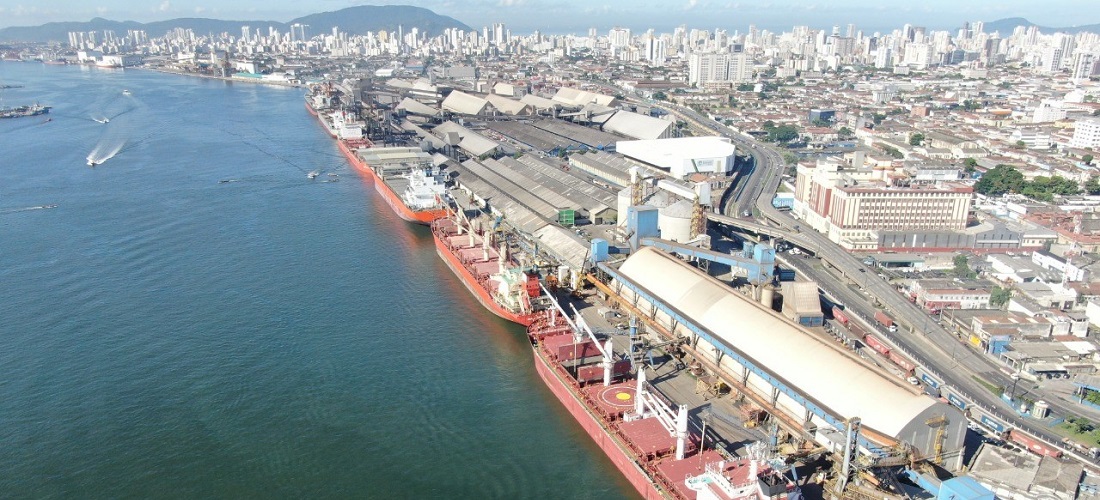
Port of Santos sees boost in corn, soy exports year after start of Ukraine war
Feb, 27, 2023 Posted by Gabriel MalheirosWeek 202310
The war in Ukraine completed one year on Friday, February 24, and, much to the surprise of everyone, it favored grain exports from Brazil in 2022. In this sense, the Port of Santos has become the country’s main gateway for commodities like corn and soybeans. The international sanctions imposed against Russia and the closure of ports in Ukraine, one of the largest corn and wheat producers, gave leeway for Brazil to gain space in the foreign trade of commodities, although not immediately.
“The beginning of the war caused an impact on the international flow of wheat, corn, and fertilizers, as Russia is a vital trading partner for Brazil. In the beginning, coffee exports were halted, and [shippers] faced the increase in fuel prices, which led to an increase in maritime freight,” said José Roque, executive director of the Union of Maritime Navigation Agencies of the State of So Paulo (Sindamar).
However, the annual balance sheet released by the Santos Port Authority (SPA) confirms the increase in the volume of corn and soybeans shipped compared to the previous year. Between January and December 2022, the Santos port complex shipped 16.3 million tonnes of corn, up 80.3% compared to 2021 (9 million). As for the soy complex, 34.6 million tonnes were exported over 30.2 million in 2021 — an increase of 14%.
“Previously, Brazil was a major corn exporter between June and January, but last year exports began in March and have continued to be energetic,” said Roque. He believes that if the armed conflict in Ukraine continues, it will change Brazil’s position as a strategic country in the international food supply chain.
“The war should allow the Port of Santos to continue expanding its export volume, as the conflict limits the outflow of grains through Ukraine, and Brazil ends up replacing this volume in the world chain. Furthermore, with the consolidation of Brazilian corn exports to China — with governments reaching an agreement and Brazil adapting to Chinese impositions — we have everything in place to make China an important destination for corn while remaining our most important destination for soybeans.”
For the executive director of Sindamar, “if the forecast of record production of soy and corn are confirmed, and we get spared from crop failures due to weather conditions, 2023 has everything to be another year of record grain exports in Brazil and, logically, Santos will continue to be the main outlet corridor.”
See below the export volume of soybeans and corn that departed the Port of Santos between Jan 2019 and Jan 2021, according to DataLiner.
Port of Santos: soy and maize exports | Jan 2019 – Jan 2023 | WTMT
Source: DataLiner (click here to request a demo)
Stroke of Luck
Economist Denis Castro observed that Brazilian foreign trade was favored by the global food crisis, despite the rise in shipping costs. “Rising diesel and maritime freight prices, as well as a container shortage, impacted exports, making them significantly more expensive. However, Santos continues to set cargo throughput records because, as an exporter, Brazil had a stroke of good luck since our products are based on agricultural commodities”.
According to Castro, the market will remain heated for Brazil, which is expected to be the third largest food exporter in the coming years, trailing only China and the United States. “The rise in the agricultural commodities market benefits Brazilian trade, but it has a negative impact on food prices and the domestic market. In addition, the Brazilian people are feeling the effects of food inflation, which has increased demand on the international stage.”
The general director of the National Association of Cereal Exporters (Anec), Sérgio Mendes, estimates that corn exports should remain high after reaching a point of no return. This trend is explained by “the vocation of our economy and the productive capacity of our agriculture, with a favorable topography and climate.”
“It is evident that, for the time being, the exit from the market of an import grain supplier creates space for other suppliers. However, I should stress that cron has been soybeans’ greatest companion when it comes to crop rotation in the same field. This trend should grow even more shortly, ” commented Mendes.
Fertilizers in Santos
“Currently, vessels carrying fertilizers from Russia are arriving, docking, and unloading cargo normally. The impact of the sanctions was mostly felt last year, shortly after the outbreak of the war, but it soon began to normalize over the year,” said the executive director of the Union of Maritime Navigation Agencies of the State of São Paulo (Sindamar), José Roque.
Brazil imports around 85% of the inputs it needs for agricultural production, with almost 30% coming from Russia and Belarus. However, there was no shortage. “Brazil, like all other consuming countries, reduced fertilizer imports by 9% in the comparison of 2022 with 2021 – from 43.7 million tonnes to 39.8 million. At the end of 2022, we noticed that Brazil had an oversupply of fertilizers and began to re-export to other countries,” said Roque.
Roque also mentioned that “importers tried to bring fertilizers from other sources, but in smaller volumes, to meet an urgent need. The situation is gradually normalizing, but it is still not 100%, and the war has greatly affected the financial sanctions.”
Source: A Tribuna
To read the original report, visit: https://www.atribuna.com.br/noticias/portomar/porto-de-santos-ve-alta-nas-exportacoes-de-milho-e-soja-apos-um-ano-de-guerra-na-ucrania
-
Mar, 09, 2022
0
Brazilian wheat exports shall total 502.608 thousand tonnes in March
-
Economy
Nov, 19, 2021
0
GECEX reduces import tax to increase clean energy production
-
Economy
Jan, 20, 2023
0
Argentina trade surplus in 2022 shows significant drop
-
Trade Regulations
May, 17, 2021
0
Brazil wants to cut Common External Tariff by 20%, with or without Argentina


